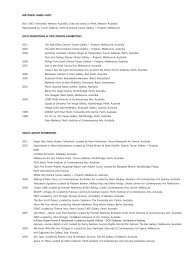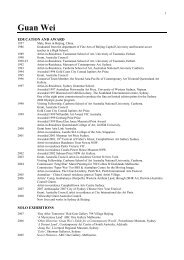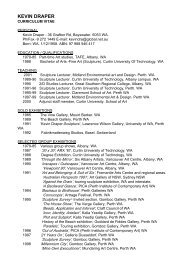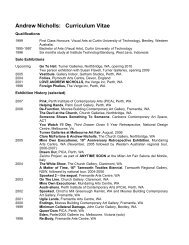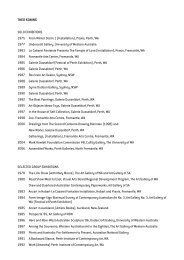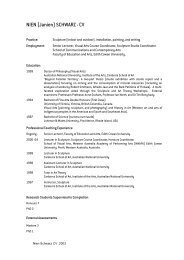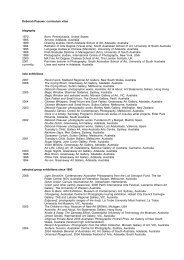and then what? (and then what?)2A few years ago Paul Hinchliffe and I sat in a Leederville coffee shop talkingabout the weather. It was raining. We were clear about that. Which was good,because I was far from clear about a definition of Paul’s “art practice”. That’swhat we were really there <strong>to</strong> discuss, for a newspaper article I was trying <strong>to</strong>write. Paul <strong>to</strong>ld me he’d made sculptures on the beach at Quinns Rock. Thathe left them there. Didn’t even take pho<strong>to</strong>s. Maybe people stumbled uponthem. Maybe they were puzzled. Maybe they weren’t. He <strong>to</strong>ld me how he satdown with an international atlas, found a street name and sent a packageoff <strong>to</strong> an unknown addressee. It was a gift. He talked about the Heimatlos(homeless) project. Performances in carparks. Subterfuge in art galleries.Conceptualism and hobo-ism uniting. Just like Jack Kerouac and RichardLong said it would.We shook hands and I ran <strong>to</strong> my car. I got soaked <strong>to</strong> the skin. I shivered, wen<strong>to</strong>ver my notes in the office. The rain got harder as I typed them out, drowningout my keyboard plucking. My edi<strong>to</strong>r didn’t like the result. There was no hook.He’d as soon can the s<strong>to</strong>ry, if I didn’t mind. And I didn’t. Not really. For me,the interview was just another chance <strong>to</strong> piece <strong>to</strong>gether a puzzle I’d beentrying <strong>to</strong> figure out for a decade or so, since experiencing Paul as a lecturerat art school.Okay, critique is the wrong word. U<strong>to</strong>pia doesn’t await. Desire rules that out.Like Ramsay Street, art is a cul de sac <strong>to</strong> which we return again and againsearching for something, finding that content, context, perception, and plainold longing are bound in<strong>to</strong> the one infuriatingly dumb object - a thing on thewall. Or Harold Bishop.So, sure, Paul is putting things on the wall these days. And then what?We can puzzle them out, but will they have s<strong>to</strong>pped functioning, will we becomplete when we’re done sleuthing? This mirrors Yeats queries in his poem“What Then?”:‘The work is done’, grown old he thought,‘According <strong>to</strong> my boyish plan;Let the fools rage, I swerved in naught,Something <strong>to</strong> perfection brought’;But louder sang the ghost, “What then?” [2]Despite our best intentions, nothing will be resolved. The work, (all work),remains fugitive, a series of offerings, openings and refusals, doors slammedin the face, heads turned abruptly.To me, dopey and callow <strong>to</strong> the marrow, Paul was the unexpected incarnate.I’d arrived there, you know, just wanting <strong>to</strong> make stuff. Paul never made stuff.Or the stuff he made was more like anti-stuff - blank books, verbal imagesof Pythagorean formulae. Paul was the guy we first heard about Lacan andDerrida from. But, unlike so many of us who later delighted in what riot grrrlband Le Tigre call Fake French [1], he wasn’t name-dropping. And he wasn’t“applying theory” either. He was inside it, tied up and twisted. To be honest,it was kinda painful <strong>to</strong> see. Yet, from remote Lacanian lacunae he made usask ourselves what we were looking <strong>to</strong> art school for. He made us realise thatart is fundamentally about the transference. Art is about the questions weask of it, the responses we want back from it. So, when identity politics wereall the rage, when lines were being drawn in the sand, Paul was on<strong>to</strong>logicalman. Yes, it was unsettling. He frustrated us enough <strong>to</strong> make us think forourselves.At the same time he teased us. Thinking for ourselves, properly, was adiscursive impossibility. With Paul there were no platitudes <strong>to</strong> settle upon.So you’ll forgive me if I admit I’m suspicious of his new work. Work in a galleryno less. Work that seems sumptuous, even. I don’t trust my reaction, mypleasure. Mostly I don’t trust him. I’ve been burnt enough times <strong>to</strong> knowthat any claim <strong>to</strong> sensory pleasure is deeply rooted in a critique of suchphenomena.Like Lacan, Paul refuses <strong>to</strong> play the good daddy, <strong>to</strong> be our friend, <strong>to</strong> console.I find no comfort in this.And yet, I’m invigorated. Though I want the work <strong>to</strong> love me back, <strong>to</strong> let melove it, there’s something tragically beautiful about the dilemma. The new work<strong>to</strong>ys with this, makes us think it will, maybe, in the future, when the time is rightand the moon is high. It’s something old Gatsby would understand, and myguess is Paul and Jay would have been soul mates, knowing that everythingis out of reach, even themselves, even as they dream it otherwise.This <strong>to</strong>o is a projection. Narrative, poetry, all that. Another self-madeconsolation.It’s annoying. Paul reminds me how much I need these things, how weak I am.Again, I find no comfort in this. And can find no graceful way <strong>to</strong> exit this text.There is always another “what then?”And maybe I still don’t really get it anyway.It’s raining <strong>to</strong>day. Did I mention that?Robert CookNotes[1] Le Tigre. (2001). “Fake French”, on Feminist Sweepstakes,Tilt Records: Sydney. They sing: “I’ve got - the new sincerity.I’ve got - a secret vocabulary. I’ve got - dialectical sprecstime.I’ve got - a conceptual stunt double. I’ve got - site specificity.I’ve got - flow disruption. I’ve got - wildlife metaphors. I’ve got- post-binary gender chores....My Fake French is hot. You can’tmake me s<strong>to</strong>p”.[2] W.B. Yeats. “What Then?”, in Seamus Heaney, (2002).Finder’s Keepers: selected prose, 1971-2001. faber and faber:London. p.109.
hinchliffe’s paradoxesnotes <strong>to</strong>wards a speculative his<strong>to</strong>ry of the reversed canvasLets start with Blue Paper (p.9) first of the grey series. Like all these works, i<strong>to</strong>scillates between a series of flat canvases, two of them back-<strong>to</strong>-front on thisoccasion, and an illusion of a simple, 3D shape: in this case an empty boxwith its lid held mysteriously open on a plane exactly parallel with the <strong>to</strong>pmostplane of the opening whose interior it exposes. Like every other work in thisshow, the illusion is both punctured and sustained by the reversed canvas orcanvases: here a pair of triangular stretchers forming the apex of the irregularfive-sided plane, shaded in three <strong>to</strong>nes of grey, each a separate canvas - oneof Hinchliffe’s perplexing rules. The reversed canvases puncture the illusionby exposing part of its inner structure. But that inner structure also sustainsthe illusion because the braces correspond <strong>to</strong> the inner edges and side of thebox if it were a box and not a series of flat canvases thus revealed. The flat andsolid geometry flip in<strong>to</strong> each other very starkly in this example. Illusionisticallythere is no greater space depicted in the work than between the right-handedge of the brightly illuminated lid and the bot<strong>to</strong>m of the darkly shadowedleft-hand side of the box, but because the brightly illuminated lid seems <strong>to</strong>be the same diamond shape as the right-hand side of the box (whose shadeis between the other two), this serves <strong>to</strong> flatten the illusion, yet the differencein shade puts them at 90 degrees <strong>to</strong> each other, which reinforces the illusionagain. The artist observes that it would have been perfectly possible for him<strong>to</strong> paint the illusion of the inside of the box that the two reversed canvaseswith all their signs of workmanship constitute so imperfectly, but this wouldnot have been <strong>to</strong> ‘<strong>catch</strong> the <strong>herring</strong>’ in the same way or <strong>to</strong> the same degree.The audacity of showing the artifice behind the illusion seems <strong>to</strong> expose anexchange or slippage between two worlds of meaning that reinforce or canceleach other out <strong>to</strong> different degrees in different works. What are these worldsand what are their relations with each other?I doubt if I will provide an adequate answer, but the preoccupation with theartifice behind the illusion as part of the illusion has a long and distinguishedhis<strong>to</strong>ry that may at least deepen the question, if only by a process ofelimination. I shall structure this essay by moving from a work in the presentexhibition <strong>to</strong> some argument about past paintings that depict reversedcanvases, then back <strong>to</strong> another work by Paul, flip-flopping in and out of timelike Paul’s works do in space.On the face of it, I cannot think of a greater distance in worlds from Hinchliffe’sgeometrical traps and trips than Henry James’ literary dramatization of humanfronts and backs in The Europeans (1878), set in the sternly Protestantatmosphere of nineteenth-century New England. As the church bell <strong>to</strong>lls itsSunday summons, Gertrude is joined by her sternly reproachful elder sister,Charlotte, who is oddly attired in ‘a long red India scarf, which, on the front ofher dress, reached <strong>to</strong> her feet.’ An equally odd conversation ensues aboutthis. Charlotte feels uncomfortable that so much of her scarf hangs down atthe front, and Gertrude tastefully loosens and rearranges it so that it should‘look differently behind.’ Charlotte is alarmed by the implications of thissar<strong>to</strong>rial makeover and sharply corrects it by observing that‘Indeed, I don’t think it matters. … how one looks behind.’‘I should say it mattered more,’ said Gertrude.‘Then you don’t know who may be observing you. You are no<strong>to</strong>n your guard. You can’t try <strong>to</strong> look pretty.’Charlotte received this declaration with extreme gravity. ‘I don’tthink one should ever try <strong>to</strong> look pretty,’ she rejoined earnestly.Amusing in itself, this passage reveals a series of exquisitely ridiculoussubstitutions when read in the context of debates of the time about theconflicting claims of aestheticism (art for art’s sake) and the morality of art.The chief representative of the moral camp in England was the great Vic<strong>to</strong>riansage and uomo universalis John Ruskin, who in the 1850s described himselfmounting a sacristan’s ladder in the Venetian Church of San Giovanni ePaolo <strong>to</strong> observe the effigy of the recumbent Doge Andrea Vendramin bythe Renaissance sculp<strong>to</strong>r Tullio Lombardo. On reaching the <strong>to</strong>p of the ladderhe is seized with indignation. ‘At first I thought it had been broken off, but onclearing away the dust, I saw the wretched effigy had only one hand, andwas a mere block on the inner side. The face, heavy and disagreeable in itsfeatures, is made monstrous by its semi-sculpture... it having been supposedthroughout the work that the effigy was only <strong>to</strong> be seen from below, and fromone side.’ Ruskin’s verdict on the heartless expediency of the Italian sculp<strong>to</strong>rof this Catholic <strong>to</strong>mb opened an important chapter in the his<strong>to</strong>ry of Britishtaste, for as a consequence vigorous Anglican divines flocked <strong>to</strong> Italy <strong>to</strong>derive the ‘idolatry’ and Mariolatry’ <strong>to</strong> be found in the churches, <strong>to</strong> makesure that sculp<strong>to</strong>rs had not neglected their duty by completing only thoseparts of their work that were visible <strong>to</strong> the public.’ By transforming the issue ofthe sculp<strong>to</strong>r’s moral duty <strong>to</strong> complete the invisible flank of the dead Doge’srecumbent effigy in<strong>to</strong> the rather different issue of whether a young womanvery much alive should draw attention <strong>to</strong> her posterior in church by the wayher scarf was hanging introduces a wonderfully absurd sexual fac<strong>to</strong>r in<strong>to</strong> what<strong>to</strong>day might seem an equally absurd question of aesthetic morality, though italso introduces an aesthetic question in<strong>to</strong> a novelistic interlude, a slice of life.The only value of such a comparison might be <strong>to</strong> illustrate how utterly remoteHinchliffe’s preoccupations are from the living or the literary, for there isnothing circumstantial about the pure cube of Blue Paper except the humansigns of labour on the reversed canvas. But if we turn from this work <strong>to</strong> TheLast Leaf (p.15), then perhaps a spectrum opens up in this respect. If thebox with the lid was in the league of a Pla<strong>to</strong>nic form, Paul points out that TheLast Leaf, an empty rectangular pillar hinged in the middle and opened outat ninety degrees, is of human scale. He jokingly called it a lady cut in half,alluding <strong>to</strong> the magic trick which depends on a flash of sexual tension as



